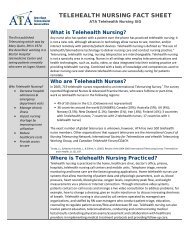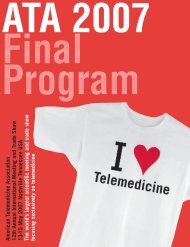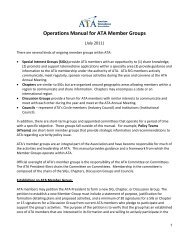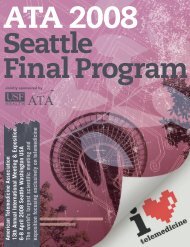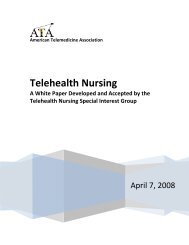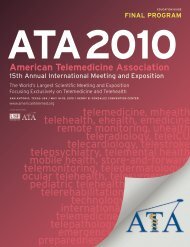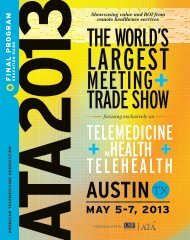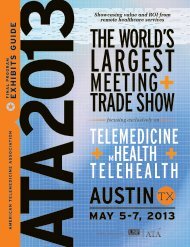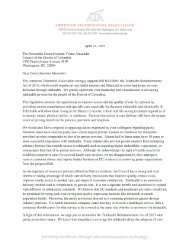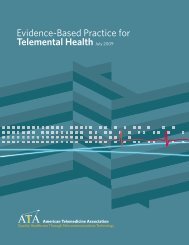CONCURRENT ORAL PRESENTATIONS ABSTRACTSprovider assessments on a case-by-case basis on the impact of care on patienttravel with an accurate assessment of patient locations and ‘‘intended’’ traveldestinations for care. An earlier pilot study conducted in 2009 that reviewedapproximately 6,000 cases revealed savings of $11.50 to the Medicaid programfor every $1 spent on reimbursement, with the added benefit of preventing4,777 lost days at work and 1,444 lost days at school for children. Thecurrent study extends the analysis through 2012 and further supports therationale for state Medicaid programs to reimburse for store and forward<strong>Telemedicine</strong>.Objectives:1. Understand the impact of telehealth on patient travel.2. Understand an accurate model for predicting travel savings of telehealth.3. Implement a methodology to measure travel savings from store-andforwardtelehealth11:00 am–12:00 pm Monday, May 6, 2013INDIVIDUAL ORALSession Number: 002Session Title: SUCCESSFUL TELEMEDICINE BUSINESSENTERPRISESTrack: Finance and Operations IBallroom EMODERATOR: Thomas S. Nesbitt, MD, MPH, Associate Vice Chancellor.UC Davis Health System, Sacramento, CA, USA.696 THE LONG-TERM EFFECT OF TELECARE ON MEDICALEXPENDITURES: NINE-YEAR EXPERIENCE OF A JAPANESE TOWNMasatsugu Tsuji, PhD, Professor 1,2 , Yuji Akematsu, PhD 3 .1 University of Hyogo, Kobe, Hyogo, Japan, 2 National Cheng Kung University,Tainan, Taiwan, 3 Osaka University, Toyonaka, Osaka, Japan.Although the economic effect of telemedicine is mostly desired and expected,very few succeeded in demonstrating this. Accordingly, long-termeffects are not obtained so far. This paper aims to examine the long-termeffect of telecare (e-Health) on medical expenditures and treatment days in aproject of Nishi-aizu Town, Fukushima Prefecture, Japan from 2002–2010,which has been implementing the project to maintain the health of the elderlyor patients at home. In addition, this paper attempts to identify howtelecare reduces medical expenditures in the long-run and which chronicdiseases reduced medical expenditures or treatment days largely by telecareuse.Materials and Methods: The method of analysis is to compare the aboveoutcomes of two groups, namely users (treatment) and non-users (control) ofthe system based on the receipt data issued by National Health Insurance usingrigorous statistical analysis. Our previous papers used five-year data from2002 to 2006, and this paper expands the period of analysis to four more years.The samples in this analysis are the same as those in the previous analysis, butthe number of samples used here is reduced sharply, namely 90 of users and118 of non-users.Results: The results obtained so far are as follows: outpatients medical expendituresof all diseases and treatment days are almost the same in bothgroups, while if diseases are restricted to chronic diseases such as heart diseases,stroke, diabetes, and hypertension, then above two variables of thetreatment group are smaller than those of the control groups. In this nine yearsdata, the almost same results are obtained, and this paper analyzes how thislong-term effects are obtained. In particular, we focus on how four-year agingaffected their medical expenditures, and whether there was any change intheir telecare use such as frequency of use and their subjective beliefs of healthcondition.Conclusion: This paper demonstrates the role and effect of telecare or e-Health, which will provide the economic foundation or a basis of reimbursementfrom medical insurance. Some obstacles for telemedicine and howto promote it are also discussed.Objectives:1. Effect of telemedicine in medical expenditures2. How telecare reduces medical expenditures in the long-run3. Situations of telecare in Japan316 THE VIRTUAL VISIT PROVIDER: A NOVEL PRIMARY CARECAREER PATHPRESENTERS AND CONTRIBUTING AUTHORS:Benjamin Green, MD, Medical Director.Carena, Inc, Seattle, WA, USA.The future of Primary Care as a career is grim-medical students areflocking to specialty fields for the buzz, lifestyle, and compensation. Notenough new providers are choosing Primary Care as a career path, leavingtoo few providers struggling to carry the torch. This is bad for the providersleft in the field, and for the patients trying to get care. Primary Care viatelemedicine may be a solution to this problem. For the provider, providingcare via telemedicine has some real advantages in quality of life and workthat make its attractiveness begin to rival specialty care as a career option.‘‘Virtual’’ physicians, nurse practitioners and physician assistants can be avery real piece to the puzzle of solving the national Primary Care shortagecrisis by drawing more individuals back into the field. Real world case study:Primary Care providers at Carena Medical Providers of Seattle, WA haveembraced telemedicine as a full-time career, realizing a favorable lifestyle,professionally rewarding practice, and leadership within their field. Additionally,these providers have provided much needed support to their fellowcommunity PCPs, creating a symbiotic relationship that can helpdisprove the demise of Primary Care as a career. Most encouraging, ProviderSatisfaction metrics among this group are quite remarkable, offering tremendouspromise for the future. Who are these providers and how do wedevelop more? Why were they attracted to this care delivery model? How dolocal, office-based PCPs benefit?This individual oral presentation will:- Describe the challenges of sustaining primary care as an attractive careerpath- Present <strong>Telemedicine</strong> as a novel career option for the PCP- Discuss opportunities for supporting the existing office-based PCP- Present a real world Medical Group employing PCPs on a fulltime basis todeliver <strong>Telemedicine</strong>- Offer promising Provider metrics related to professional fulfillment,lifestyle satisfaction, and compensationObjectives:1. Present the promise of <strong>Telemedicine</strong> as a novel career option for thePrimary Care Provider2. Present a real world Medical Group employing Primary Care Providerson a Full Time Basis to deliver <strong>Telemedicine</strong>3. Offer promising Provider metrics related to professional fulfillment,lifestyle satisfaction, and compensationª MARY ANN LIEBERT, INC. 2013 TELEMEDICINE and e-HEALTH A-31
CONCURRENT ORAL PRESENTATIONS ABSTRACTS600 TELEMEDICINE - HEALTHCARE REFORM WITHOUT ALL OF THEPOLITICSPRESENTERS AND CONTRIBUTING AUTHORS:Joe Peterson, MD, CEO & Director.Specialists On Call, Leesburg, VA, USA.Love it or loathe it, healthcare reform remains the law of the land. It is aseismic shift in healthcare that impacts every American on multiple levels.While it remains a complicated subject that continues to polarize our nation,another transformation in healthcare is revolutionizing medicine without anyof the political fallout. <strong>Telemedicine</strong> is a thriving industry that shares many ofthe same virtues and goals of healthcare reform - expanding access tohealthcare, improving the quality of care and reducing the costs of that samecare. Unlike healthcare reform, however, the early returns on telemedicine areoverwhelmingly positive. Most programs are delivering impressive clinicalresults along with incredibly high patient satisfaction scores. Private telemedicinecompanies are also combining equally positive clinical and patientsatisfaction data with a return on investment that is attractive to both hospitalsand their patients. While the efficacy of healthcare reform continues tobe debated, a real change in healthcare is occurring right before our eyes.Objectives:1. Healthcare reform has many shapes2. <strong>Telemedicine</strong> is truly transformative3. Healthcare shouldn’t fear change527 PRICE-CHECK, AISLE 1: SELLING PROVIDER-DEVELOPEDTELEMEDICINE PRODUCTS TO THE MASSESPRESENTERS AND CONTRIBUTING AUTHORS:Curtis Lowery, MD, Chairperson for the Department of Obstetrics andGynecology.University of Arkansas for Medical Sciences, Little Rock, AR, USAWhen a healthcare provider at a non-profit institution pioneers a brilliantconcept fueled by telemedicine, the idea of ‘‘profit’’ is often lost or neverconsidered. However, many times that innovative telemedical idea, if offeredon the public market, could benefit many others who could adapt the conceptand replicate it at their local level, not to mention the benefits offered to theinnovator who could sell his or her product. An academic medical center with along-standing telemedicine history has begun a ‘‘for-profit’’ venture in packagingand selling telemedicine ideas as a product line to meet the needs of othernetwork owners who have the infrastructure but desire more applications toutilize that infrastructure. With the establishment of a for-profit entity, thoseproducts will bring much-needed sustainability income to the pioneering telemedicineprogram. To date, this academic medical center spin-off business isactively selling a neonatal intensive care unit webcam system to hospitals thatcan offer remote family members the ability to view their hospitalized infantthrough a successful monitoring system and a proven product. Other ideas onthe horizon include mobile health applications and other concepts in remotemonitoring. While it is commendable to have a telemedicine network in yourownership, that network is only as good as the services and products deployedover it. Many networks, even those tried and true, are looking for ways toexpand their product line to reach more patients and providers in need. Forthose providers who have created niche products, this market could yieldbenefits to all with some accounting restructuring and legal considerations.These and other lessons learned will be discussed in this presentation.Objectives:1. Audience will learn how to produce a product line from their telemedicineideas and devices.2. Audience will learn how to navigate the creation of for-profit venturesfrom the basis of non-profit organizations.3. Audience will learn how market could yield benefits to all with someaccounting restructuring and legal considerations.11:00 am–12:00 pm Monday, May 6, 2013INDIVIDUAL ORALSession Number: 003Session Title: DESIGNING FOR SCALETrack: Finance and Operations II Ballroom FMODERATOR: Adam Darkins, MD, FRCS, Chief Consultant, TelehealthServices.Department of Veterans Affairs, Washington DC, USA.467 THE INFLUENCE OF USER-CENTRED DESIGN AND THEDEVELOPMENT OF A LARGE-SCALE TELEHEALTH PROGRAMPRESENTERS AND CONTRIBUTING AUTHORS:Brendan Purdy, BN, MN(c), Program Coordinator, Telehealth,Dana Chmenitsky, BMR(PT), MBA, Carol Toenjes, BScN, RN,Joseph A. Cafazzo, PhD, PEng, Peter G. Rossos, MD, MBA, FRCP(C), FACP.University Health Network, Toronto, ON, Canada.The University Health Network (UHN) is an academic health sciences centrelocated in Toronto, Ontario, Canada. Over the last decade, the UHN TelehealthProgram has demonstrated steady growth in clinical consultations usingvideoconferencing technology. In fiscal 2011/12 the Program supported over3,000 clinical consultations across Canada in multiple specialty areas withinthree hospital sites. Since its inception in 2002, the program’s evolution andsuccess has been influenced by the principles of User-Centred Design (UCD),through the collaboration with Healthcare Human Factors at UHN. UCD focuseson task analysis and design iteration, which is ultimately associated witha high degree of user acceptability. In healthcare, clinician acceptance iscritical for any new initiative to be sustainable. Consequently, UHN Telehealthhas incorporated UCD principles to improve the level of user acceptance in theadoption of videoconferencing technology to enhance clinical service deliveryand sustain telehealth practice.Methods: This presentation will provide the following examples of how UCDprinciples have been incorporated into the establishment and evolution of alarge telehealth program.. Technology selection, deployment, and adoptionSelection of the most appropriate technology based on user needsleading to successful adoption across clinical sites.Evolution from a studio based telehealth model to the introduction anddeployment of mobile videoconferencing technology at the point ofcare within the clinic areas.. Space designDesign of the telehealth studio room to enhance the user experiencebased on best practices - including a brief description of a researchpaper that looked at optimizing the eye gaze angle.. Workflows and System IntegrationDescription of how UHN Telehealth engaged users in the various clinicalsettings to customize and adapt telehealth clinic workflows and processes.Focus on iterative changes to allow progression from pilot projects inselect clinical areas to the integration of telehealth into multiple clinicalpractices across UHN.. Clinician EmpowermentPhased model of UHN Telehealth Clinician Empowerment illustratedwith the integration of telehealth applications for Lung Transplantation.Results: Elements of UCD can contribute greatly to the design, successfulimplementation, and evolution of telehealth programs within a large academichealth care facility. Considerations also need to include leveraging andA-32 TELEMEDICINE and e-HEALTH 2013



